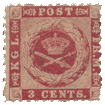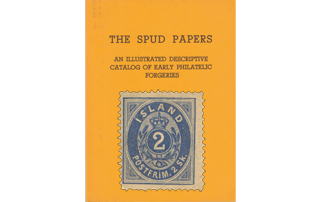Album Weeds – Danish West Indies

 1860, 1867 & 1873. 3 Cents, carmine
1860, 1867 & 1873. 3 Cents, carmine
Genuine
Nicely engraved in épargne; watermarked with a crown, the same as the early Danish stamps. The 1860 issue has deep reddish-brown gum, which also appears to have discolored the paper to a sort of buff; the 1867 issue has dark yellow gum; and the issue of 1875 has white gum. Most of the stamps show a burelé, like that of the early Danish. The base of the crown is ornamented with four pearls, alternating with three oblong jewels, all of them dark on a light ground; the order being pearl, jewel, pearl, jewel, pearl, jewel, pearl. There is a caduceus, or winged rod, entwined with serpents, each side of KGL., each side of POST, and each side of FR.M. There is a large round stop after KGL., a similar one after FR., and M., but none after POST. The stop after CENTS, which is the same size and shape as the others, is decidedly nearer to the S than to the end of the label. The 3 is nicely shaped and fat. The wreath very nearly touches the frame at the bottom, but nowhere else. The ground-work, between the wreath and the frame, is composed of dotted lines, or rather lines of dots, very regularly arranged in waves or curves. The small ends of the little post-horns in the upper squares point to the inner top corners of the said squares; while the small ends of the horns in the lower squares point to the outer top corners of their containing-squares.
First Forgery
Very badly lithographed, on hard, almost yellow paper; imperf., no watermark; white gum. There is no burelé. The base of the crown is ornamented with three white pearls, with a dark outline, on a white ground. There is no stop after KGL., none after the M of FR. M., and a shapeless, large white blotch, instead of a stop, after CENTS. This blotch is equally distant from the S and the end of the label. The 3 is very thin, and the top of the figure is of an absurd shape. The wreath just touches the frame each side. The dots in the groundwork, between the wreath and the frame, are very tiny, and irregularly arranged; and the ground is much too light. The whole impression is very poor, and not likely to deceive.
Second Forgery
This is much better than the other, but the only specimen which I possess is printed in lilac, instead of carmine or rose, so the colour will at once condemn it. Nicely lithographed, on thin, greyish-white wove paper (no gum on my specimen); imperf.; no watermark; no burelé. The base of the crown is ornamented with six dark jewels, on a white ground; some being oblong, and some diamond-shaped, but no pearls. There is no caduceus in any of the frames. There is a tiny and faint stop after KGL., a stop after POST, large and round, but none after FR. or M., and, as far as I can make out, under the postmark of my specimen, none after CENTS. The C of the latter word is not the nice oval shape of the genuine, but too broad at the top. The wreath touches the frame on the left side. The groundwork, between the wreath and the frame, is composed of crossed, oblique lines, instead of dots. The post-horns in the upper squares have their small ends pointing to the outer top corners of their squares, and those in the lower squares have their small ends pointing to the inner top corners of their squares, i.e., exactly the opposite of the genuine, and of the first forgery.
Postmarks
Genuine.—Five concentric circles, as in the old Danish.
Forged.—The same; also a large circle, with letters and numerals.




 1874. 1, 3, 4, 7 & 14 Cents.
1874. 1, 3, 4, 7 & 14 Cents.
Genuine
Nicely engraved in épargne, on wove paper, white, and rather thick; machine-perforated 13 1/2, which, by the way, is called “13” in some of the cataloges. All the values bear the crown watermark, similar to that on the early stamps of the mother country. There is a very distinct hyphen between the words DANSK and VESTINDISK. The vertical lines of shading in the central oval go quite up to the oval, without leaving any white space between the lines and the colored oval. The cross on the top of the crown touches the colored oval. The wreath round the central design is evidently a wreath of barley. The bell-end of the post- horn is nicely-shaped, with a little white place inside the bell.
Forged
Lithographed, on thinnish, white wove paper; no watermark; pin-perf. 13. There is no hyphen between the words DANSK and VESTINDISK. The vertical lines of shading in the inner oval do not go close to the colored oval outside them, so that there is a small white space, nearly all the way round, inside the said colored oval. The cross on the top of the crown does not touch the oval above it. The wreath cannot be said to be barley; it might be leaves, or thistle-buds, or almost anything. The post-horn is not nicely drawn: the bell-end, especially, is very clumsy, and ends in a sort of club. The double colors of the genuine have been nicely imitated; and I think that these forgeries have had a good sale. In die genuine stamps, the central numeral and the other white parts are slightly embossed, as is usual in épargne engravings. As these forgeries are lithographs, I need hardly say that they show no sign of any such embossing. They are not gummed. The genuine stamps are backed with a white crystal gum, which has a bad habit of sticking, when it is not required to do so. Some little time ago, when I was away from home for a few weeks, one of my albums had been put into a slightly damp place; and, on my return, I found that all my stamps of this set (mounted, as usual, by the top only, with a hinge) were firmly stuck down into the book. The 1870 issue of the United States has this same disagreeable peculiarity.
Postmarks
Genuine.—All my used genuine copies are cancelled with five concentric circles, very similar to the postmark of the old issues of Denmark itself.
Forged.—The obliteration of the forgeries is 62.
From: ‘Album Weeds’, 3rd edition by R. B. Eareé. 1906
![]() See also –> Spud Papers – Danish West Indies
See also –> Spud Papers – Danish West Indies












Leave a Reply
Want to join the discussion?Feel free to contribute!